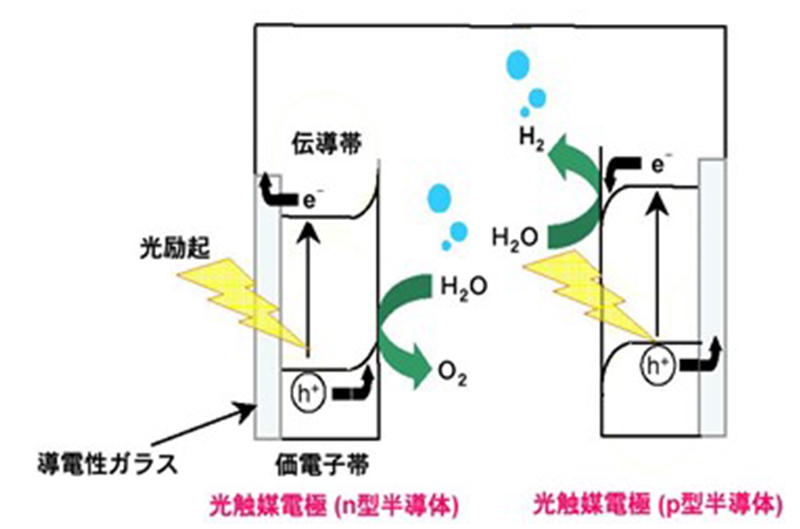Development of new photoelectrodes for water splitting
Photocatalysts are generally used in powder form. If this can be made into an electrode on a thin film, energetic knowledge of the material can be obtained and its range of applications can be expanded. It is also possible to use photocatalysts to decompose water in a photovoltaic reaction, which is different from powder photocatalysts. Therefore, we have fabricated electrodes using photocatalytic materials developed in our laboratory, investigated their photoelectrochemical properties, and conducted solar water splitting using such a system, as shown in Fig. 1.
Our laboratory has found that photocatalytic electrodes of SrTiO3:Rh, (CuGa)0.8Zn0.4S2, RGO-CuGaS2, (CuGa)0.8Zn0.4S2, and Cu3Nb0.9V0.1S4, combined with BiVO4 electrodes, are active for solar water splitting without external We have found that a photovoltaic cell combining a Cu3Nb0.9V0.1S4 photocatalyst electrode and a BiVO4 electrode shows activity in solar water splitting even without applying an external bias.

References
- Q. Jia, K. Iwashina, A. Kudo, P. Natl. Acad. Sci. USA 2012, 109, 11564.
- H. Kaga, Y. Tsutsui, A. Nagane, A. Iwase, A. Kudo, J. Mater. Chem. A 2015, 3, 21815.
- A. Iwase, Y. H. Ng, R. Amal, A. Kudo, J. Mater. Chem. A 2015, 3, 8566.
- T. Kato, Y. Hakari, S. Ikeda, Q. Jia, A. Iwase, A. Kudo, J. Phys. Chem. Lett. 2015, 6, 1042.
- S. Ikeda, N. Aono, A. Iwase, H. Kobayashi, A. Kudo, ChemSusChem 2019, 12, 1977.
